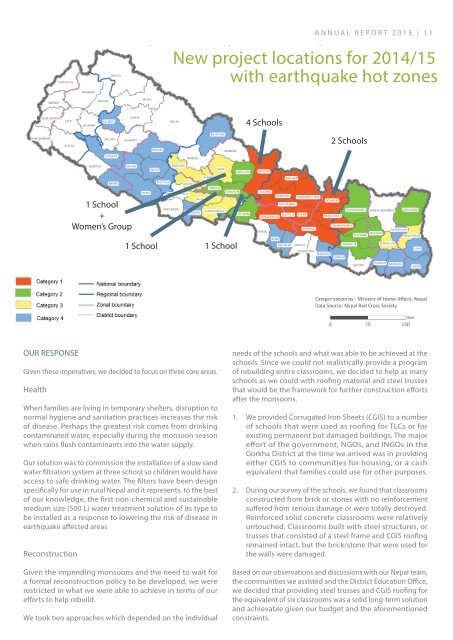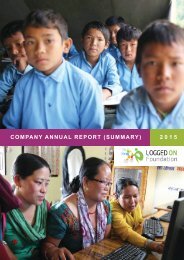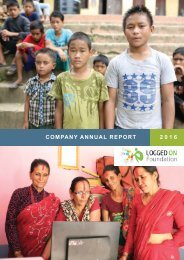Annual Report Summary 2015
Create successful ePaper yourself
Turn your PDF publications into a flip-book with our unique Google optimized e-Paper software.
ANNUAL REPORT <strong>2015</strong> | 11<br />
New project locations for 2014/15<br />
with earthquake hot zones<br />
4 Schools<br />
2 Schools<br />
1 School<br />
+<br />
Women’s Group<br />
1 School<br />
1 School<br />
OUR RESPONSE<br />
Given these imperatives, we decided to focus on three core areas.<br />
Health<br />
When families are living in temporary shelters, disruption to<br />
normal hygiene and sanitation practices increases the risk<br />
of disease. Perhaps the greatest risk comes from drinking<br />
contaminated water, especially during the monsoon season<br />
when rains flush contaminants into the water supply.<br />
Our solution was to commission the installation of a slow sand<br />
water filtration system at three school so children would have<br />
access to safe drinking water. The filters have been design<br />
specifically for use in rural Nepal and it represents, to the best<br />
of our knowledge, the first non-chemical and sustainable<br />
medium size (500 L) water treatment solution of its type to<br />
be installed as a response to lowering the risk of disease in<br />
earthquake affected areas<br />
Reconstruction<br />
Given the impending monsoons and the need to wait for<br />
a formal reconstruction policy to be developed, we were<br />
restricted in what we were able to achieve in terms of our<br />
efforts to help rebuild.<br />
We took two approaches which depended on the individual<br />
needs of the schools and what was able to be achieved at the<br />
schools. Since we could not realistically provide a program<br />
of rebuilding entire classrooms, we decided to help as many<br />
schools as we could with roofing material and steel trusses<br />
that would be the framework for further construction efforts<br />
after the monsoons.<br />
1. We provided Corrugated Iron Sheets (CGIS) to a number<br />
of schools that were used as roofing for TLCs or for<br />
existing permanent but damaged buildings. The major<br />
effort of the government, NGOs, and INGOs in the<br />
Gorkha District at the time we arrived was in providing<br />
either CGIS to communities for housing, or a cash<br />
equivalent that families could use for other purposes.<br />
2. During our survey of the schools, we found that classrooms<br />
constructed from brick or stones with no reinforcement<br />
suffered from serious damage or were totally destroyed.<br />
Reinforced solid concrete classrooms were relatively<br />
untouched. Classrooms built with steel structures, or<br />
trusses that consisted of a steel frame and CGIS roofing<br />
remained intact, but the brick/stone that were used for<br />
the walls were damaged.<br />
Based on our observations and discussions with our Nepal team,<br />
the communities we assisted and the District Education Office,<br />
we decided that providing steel trusses and CGIS roofing for<br />
the equivalent of six classrooms was a solid long-term solution<br />
and achievable given our budget and the aforementioned<br />
constraints.






